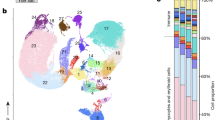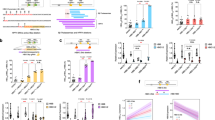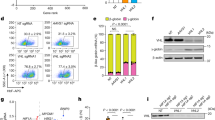Abstract
The pattern of haemoglobin production changes at the embryonic, fetal and postnatal stages of human development, reflecting the expression of different globin genes in both the α-like and β-like gene clusters1,2. Recent studies have identified alterations in the state of DNA methylation3 and sensitivity to nuclease digestion4 associated with developmental expression of the globin genes in red blood cell precursors, but the mechanism initiating these changes remains unknown. Despite the screening of large numbers of blood samples from newborn infants5,6, no mutants have been found which affect the timing of these changes (with one possible exception involving a chromosomal translocation7), thus necessitating alternative approaches to analysing the cellular basis for the timing of haemoglobin switching. Although many mechanisms are possible, the initiation of the switch from fetal to adult haemoglobin could be regulated essentially either by a developmental clock inherent to haematopoietic stem cells or by an inductive enrivonment8,9, and in an attempt to distinguish between these possibilities, we have transplanted sheep fetal haematopoietic tissue into adult animals. Although previous experiments of this type produced conflicting results10–12, the accumulated results presented here demonstrate that the pattern of haemoglobin production after transplantation is determined largely by the gestational age of the fetal donor cells.
This is a preview of subscription content, access via your institution
Access options
Subscribe to this journal
Receive 51 print issues and online access
$199.00 per year
only $3.90 per issue
Buy this article
- Purchase on Springer Link
- Instant access to full article PDF
Prices may be subject to local taxes which are calculated during checkout
Similar content being viewed by others
References
Wood, W. G., Clegg, J. B. & Weatherall, D. J. Prog. Hemat. 11, 43–90 (1977).
Wood, W. G. & Weatherall, D. J. Biochem. J. 215, 1–10 (1983).
Mavilio, F. et al. Proc. natn. Acad. Sci. U.S.A. 80, 6907–6911 (1983).
Groudine, M., Kohwi-Shigematsu, T., Gelinas, R., Stamatoyannopoulos, G. & Papayannopoulou, T. Proc. natn. Acad. Sci. U.S.A. 80, 7551–7555 (1983).
Huisman, T. H. J. & Jonxis, J. H. P. The Hemoglobinopathies (Dekker, New York, 1977).
Yoshinaka, H. et al. Hemoglobin 6, 37–42 (1982).
Weller, S. D. V., Apley, J. & Raper, A. B. Lancet i, 777–779 (1966).
Wood, W. G. Adv. physiol. Sci. 6, 101–113 (1981).
Stamatoyannopoulos, G. et al. in Hemoglobin in Development and Differentiation (eds Stamatoyannopoulos, G. & Nienhuis, A.) 287–305 (Liss, New York, 1981).
Zanjani, E. D., McGlave, P. B., Bhakthavathsalan, A. & Stamatoyannopoulos, G. Nature 280, 495–496 (1979).
Bunch, C., Wood, W. G., Weatherall, D. J., Robinson, J. S. & Corp, M. J. Br. J. Haemat. 49, 325–336 (1981).
Wood, W. G. & Bunch, C. in Globin Gene Expression and Hematopoietic Differentiation (eds Stamatoyannopoulos, G. & Nienhuis, A.) 511–521 (Liss, New York, 1983).
Weatherall, D. J., Clegg, J. B. & Wood, W. G. Lancet ii, 660–663 (1976).
Fraser, I. D. & Raper, A. B. Archs Dis. Childh. 37, 289–296 (1962).
Dan, M. & Hagiwara, A. Expl Cell Res. 46, 596–598 (1967).
Kamada, M. Yokohama med. Bull. 20, 127–135 (1969).
Kidoguchi, K., Ogawa, M., Karam, J. D., McNeil, J. S. & Fitch, M. S. Blood 53, 519–522 (1979).
Comi, P. et al. Proc. natn. Acad. Sci. U.S.A. 77, 362–365 (1980).
Wood, W. G. in Biochemical Development of the Fetus and Neonate (ed. Jones, C. T.) 127–162 (Elsevier, Amsterdam, 1982).
Keating, A. et al. Nature 298, 280–283 (1982).
Potter, C. G., Rowell, A. C. & Weatherall, D. J. Clin. Lab. Haemat. 3, 245–255 (1981).
Widmer, H. J., Hosbach, H. A. & Weber, R. Devl Biol. 99, 50–60 (1983).
Kliehauer, E., Braun, H. & Betke, K. Nature 35, 635–636 (1957).
Wood, W. G. et al. Nature 264, 799–801 (1976).
Author information
Authors and Affiliations
Rights and permissions
About this article
Cite this article
Wood, W., Bunch, C., Kelly, S. et al. Control of haemoglobin switching by a developmental clock?. Nature 313, 320–323 (1985). https://doi.org/10.1038/313320a0
Received:
Accepted:
Issue Date:
DOI: https://doi.org/10.1038/313320a0
Comments
By submitting a comment you agree to abide by our Terms and Community Guidelines. If you find something abusive or that does not comply with our terms or guidelines please flag it as inappropriate.



